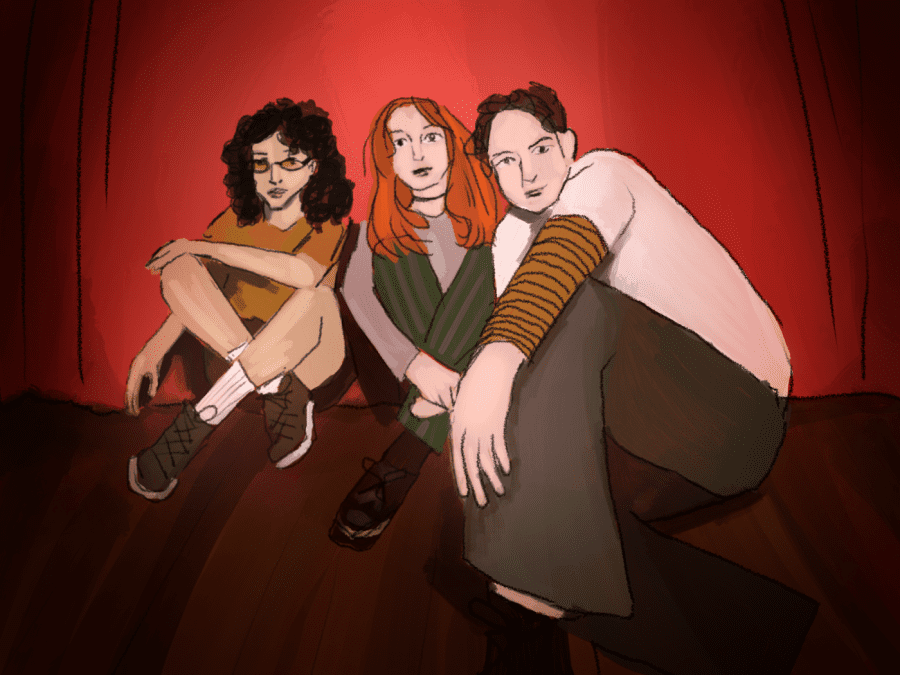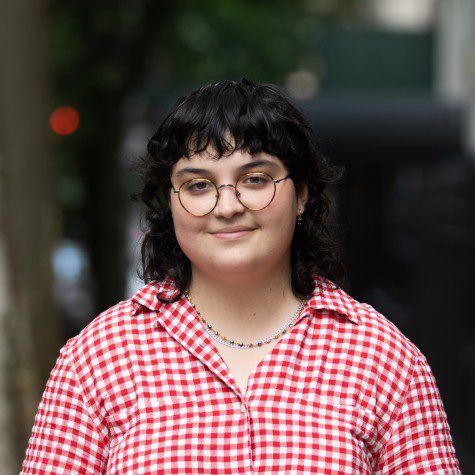Review: MUNA reimagines electropop on ‘Live At Electric Lady’
The queer band released the live EP amid their quasi-sold-out U.S. tour. “Live At Electric Lady” can be streamed exclusively on Spotify.
Musical group MUNA released a live EP. (Illustration by Susan Behrends Valenzuela)
October 31, 2022
MUNA is resilient and driven. The queer electropop band — comprised of Katie Gavin, Naomi McPherson and Josette Maskin — formed in 2013 after meeting at the University of Southern California. They soon released their debut EP, “More Perfect,” before signing with RCA Records. After the label dropped them during the pandemic, Phoebe Bridgers scooped the trio up in 2021 and signed them to her imprint Saddest Factory Records.
Getting dropped by a major label might have been the best thing to happen to MUNA — since joining Bridgers’ label, the band has enjoyed more and more success, nudging the boundaries of mainstream pop and gaining fans beyond their niche queer following. They sold out most of their U.S. and U.K. tour dates. Their biggest song, “Silk Chiffon,” has over 32 million streams on Spotify.
On Oct. 12, MUNA released their live EP “Live At Electric Lady,” which they recorded at the renowned studios in June. Located right off of NYU’s campus on West 8th Street, Electric Lady Studios was purchased by Jimi Hendrix in 1968 and constructed in 1970. Since then, several famous albums have been recorded there, including D’Angelo’s “Voodoo” and NYU alum Maggie Rogers’ new album, “Surrender.” It makes sense that rising star MUNA would get a turn in the studio.
The EP contains three songs from the band’s latest self-titled album — the hit “Silk Chiffon,” the upbeat “Anything But Me” and the reflective ballad “Kind Of Girl.” The record also features “Taken,” off of their 2019 album “Saves The World” and a cover of Taylor Swift’s acclaimed song “august.” The tracks’ arrangements differ slightly from the studio versions — at times they are more stripped-back; at others, they contain the same oomph as the studio ones while featuring a different flavor.
“Anything But Me” kicks off the EP with its chugging guitar taking on more of a rock flair. The drums seem less synthetic than the studio version but remain just as grand. As she sings equally scathing and playful lines like, “You’re gonna say that I’m on a high horse / I think that my horse is regular-sized / Did you ever think, maybe, you’re on a pony / Going in circles on a carousel ride?” Gavin’s voice is unwaveringly confident and emotionally nuanced.
The accompanying synths — their arrangements tweaked by McPherson — are just as retro and warm as the studio version, though they feel more authentically played, perhaps due to less post-production processing. On Instagram, McPherson mentioned that they use the Korg Nautilus to play their synths, utilizing both the instrument’s stock sounds as well as importing the original album’s actual synth sounds. Taken all together, this performance is faithful to the studio version, with Gavin’s intimate delivery tilting the song to a more introspective angle.
That contemplative vibe is continued on “Kind Of Girl,” a stunningly-penned, country-tinged ballad. As with “Anything But Me,” their performance of “Kind Of Girl” feels even more emotional and personal. Between Maskin’s slide guitar swells and a jangly, rhythmic acoustic guitar, Gavin sings, “I’m the kind of girl / Who owns up to all of my faults / Who’s learning to laugh at ’em all / Like I’m not a problem to solve.” While the lyrics are unchanged from the studio version, the slightly more stripped-back arrangement and focus on Gavin’s voice heighten the candid vulnerability in her songwriting.
“Taken” and “Silk Chiffon” follow the same patterns as the songs that precede them — just as great as the originals, but with a new zest. These live versions sometimes sound more restrained and delicate than their studio counterparts. One might view the Electric Lady cuts as honest and no-frills, while the original versions are explosive and extravagant — like the difference between a small town and New York City. That’s not to say that one version is better than the other, but that they each provide different perspectives on the same song. On “Silk Chiffon,” McPherson sings the second verse instead of Bridgers, who originally features on the song, offering their interpretation of being high and “feeling anxious inside of the CVS.” It’s fun to hear McPherson switch from harmonies to lead vocals, and disorienting yet refreshing to experience a MUNA verse without Gavin singing.
Notably, what impressed some fans most was not the trio’s reinventions of their songs but rather their approach to Taylor Swift’s “august,” from her highly-praised album “folklore.” A fan on Twitter shared, “Of course MUNA found a way to make ‘August’ even sadder.”
Indeed, MUNA’s cover not only places the song under a queer lens but also extends its wistful qualities by changing the key so that Gavin sings it all in her lower register, which is fluttery and simultaneously light and dark. The trio shifts the song to a more subdued state, featuring simple, slow drums and an ambient, airy pad. In the bridge’s lyrics “Remember when I pulled up and said ‘Get in the car’ / And then canceled my plans just in case you’d call? / Back when I was livin’ for the hope of it all,” Gavin sings low instead of jumping up like Swift, crafting a much more mournful tone.
“Live At Electric Lady” displays MUNA’s musicianship, proving that they are just as adept and brilliant live as they are in the studio — after catching the band’s first show of their three-night run at Irving Plaza, I felt like I accessed a new dimension to their music.
MUNA has a strong brand and ethos — at Irving Plaza, this was palpable just by stepping foot in the venue. Staff worked to get merch buyers to sign up to vote; all bathrooms were gender neutral at MUNA’s request. The band’s audience felt like a community, perhaps because of MUNA’s close relationship with their fans and their ability to rally people together and create a safe space.
The show excelled at every point, with Gavin demonstrating masterful control of her voice and McPherson and Maskin their instruments. Every band member was a dynamic performer, engaging with and reacting to one another. But what was most moving was the energized and synergetic relationship between the band and their fans — the ideal partnership between the two. It is therefore no surprise that MUNA delivers a distinctly compelling performance and musical story on this EP.
Though it sometimes feels like the trio is holding back on “Live At Electric Lady” it isn’t to the music’s detriment. Above anything, MUNA’s talent, values and voice burst through, prompting us to consider why a band like theirs is so important. After all, how many unabashedly all-queer pop bands are there?
MUNA is the answer to this shortage and the blueprint for future queer pop artists. They are a representation for queer fans of all ages and a reminder that the queer community is most powerful when it is just that — a community.
Contact Yas Akdag at [email protected].

























































































































































